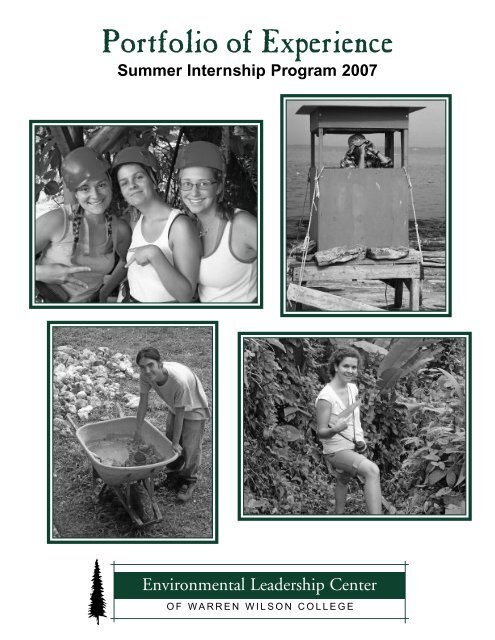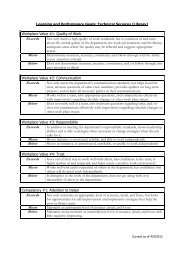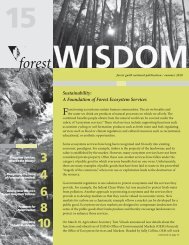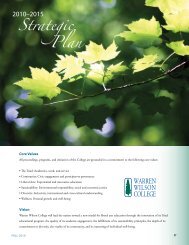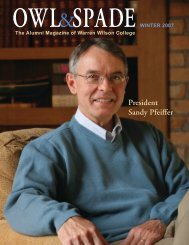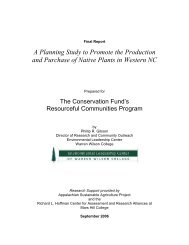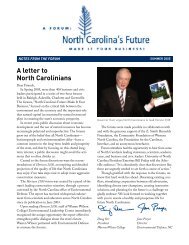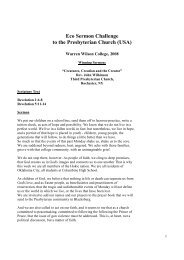Portfolio of Experience - Warren Wilson College
Portfolio of Experience - Warren Wilson College
Portfolio of Experience - Warren Wilson College
You also want an ePaper? Increase the reach of your titles
YUMPU automatically turns print PDFs into web optimized ePapers that Google loves.
<strong>Portfolio</strong> <strong>of</strong> <strong>Experience</strong>Summer Internship Program 2007Environmental Leadership CenterOF W ARREN WILSON COLLEGE
Council <strong>of</strong> AdvisorsJoel Adams - Asheville, NCSusan Andrew - Asheville, NCAnn Baker - Crossnore, NCTaylor Barnhill - Mars Hill, NCDavid Bate - Asheville, NCTerry Bellamy - Asheville, NCDawn Averitt Bridge - Charlottesville, VAAndy Brown - Asheville, NCBill Bush - Salem, SCGinger Cecil - Asheville, NCMimi Cecil - Asheville, NCLisbeth Riis Cooper - Black Mountain, NCJane Craig - Charlotte, NCJohn Curry - Asheville, NCEllie Daniels - Asheville, NCRobert Deutsch - Asheville, NCJoe Epley - Tryon, NCRic Felker - Atlanta, GAJay Fields - Asheville, NCHertha Flack - Columbus, NCGloria Howard Free - Asheville, NCJames Hendrix - Cashiers, NCMary Rich Hill - Asheville, NCPaula Holmes - Pittsburgh, PAMike Horak - Asheville, NCBen Keys - Greenville, SCFlorence Krupnick - Asheville, NCJim Kuhns - Sonoma, CAD’Etta Leach - Marshall, NCMichael Leonard - Winston-Salem, NCJay Leutze - Minneapolis, NCGovernor Jim Martin - Charlotte, NCJeanne McCarty - Washington, DCBill McCoy - Davidson, NCPamela McDougald - Tryon, NCHenry McHenry - Charlottesville, VADwight Mullen - Asheville, NCMack Pearsall - Fairview, NCHarry Petrequin - Black Mountain, NCParker Platt - Brevard, NCSally Rhoades - Asheville, NCSusan Roderick - Asheville, NCDoug Ruley - Asheville, NCSandy Schenck - Cedar Mountain, NCBonny Schley - Arden, NCBrad Searson - Asheville, NCBrandon Stephens - Sylva, NCPeter Sterling - Waynesville, NCJimmy Tanner - Rutherfordton, NCAlan Thornburg - Asheville, NCDavid Turner - Asheville, NCMark Ward - Asheville, NCEducational AdvisorsDavid Abernathy - Swannanoa, NCTom Bohn - Washington, DCJohn Brock - Swannanoa, NCHans Cole - Berkeley, CAThomas Crowe - Cullowhee, NCDean Kahl - Swannanoa, NCSusan Kask - Swannanoa, NCJulie Lehman - Swannanoa, NCCarl Leopold - Ithaca, NYAmory Lovins - Snowmass, COPaul Magnarella - Swannanoa, NCDavid Orr - Oberlin, OHEd Raiola - Swannanoa, NCSteve Runholdt - Swannanoa, NCDiana Richards - Lake Lure, NCJanisse Ray - Brattleboro, VTBob Swoap - Swannanoa, NCLou Weber - Swannanoa, NCDear Friends,Since 1996, more than two hundred and fifty <strong>Warren</strong> <strong>Wilson</strong><strong>College</strong> students have spent their summers as interns atsome <strong>of</strong> the finest environmental organizations in theAmericas. They have learned lessons that cannot bereplicated in the classroom. Hands-on lessons that engagepassion with real work, affirm commitments to make adifference in the world and toughen resolve.<strong>Warren</strong> <strong>Wilson</strong> <strong>College</strong> is known for its unique Triad <strong>of</strong>liberal arts education – academics, work and service. Thecampus is a dynamic learning laboratory – a communityknitted by a common environmental ethos. Internshipsprovide an opportunity to experience the challenges <strong>of</strong> theworld beyond, where environmental commitments are notthe prevailing ethic, and each day <strong>of</strong> conservation workrequires the energy and the determination <strong>of</strong> a politicalcampaign. Field research with world class scientists,environmental education for people from all walks <strong>of</strong> life,policy-shaping in federal bureaucracies, single-handedprotection <strong>of</strong> fragile turtle nests - summer internships suchas these have proven to be life-changing experiences.Reflecting upon the value <strong>of</strong> her 2007 Nature ConservancyInternship, Nora Purcell notes, “Individuals may not be ableto single-handedly fix problems, but they can certainlyeducate their communities. This realization has revolutionizedmy worldview, stirring me to look outside myself for solutions.”Internships provoke such insights as “revolutionized”worldviews, lifelong commitments to conservation work,and discoveries <strong>of</strong> true career paths.Now back at <strong>Warren</strong> <strong>Wilson</strong>, the 2007 Interns are recordingpublic radio broadcasts about their summer experiences forour weekly program, the Swannanoa Journal (listen to theseat www.warren-wilson.edu/~elc/ and link to SwannanoaJournal) and providing a speakers’ bureau for the campusand the region, inspiring civic clubs, faith groups, and others.These are remarkable young people, deeply committed tomaking a positive difference, and well-versed in what ittakes. We honor the 2007 Environmental LeadershipCenter Interns and invite you to read excerpts in this<strong>Portfolio</strong> about their work.Margo Nottoli FloodDirectorEnvironmental Leadership Center
Mission <strong>of</strong> theEnvironmental Leadership Center<strong>of</strong> <strong>Warren</strong> <strong>Wilson</strong> <strong>College</strong>The mission <strong>of</strong> the Environmental LeadershipCenter (ELC) is to raise awareness <strong>of</strong> local, national,and global environmental realities and to inspirecaring citizens – especially youth – to reflect, tocommunicate and to act as responsible caretakers <strong>of</strong>the earth. <strong>Warren</strong> <strong>Wilson</strong> <strong>College</strong>’s commitment toenvironmental responsibility is reflected in the programs<strong>of</strong> the ELC. Through its Internships,EcoTeam environmental education program,Catalyst newsletter, Heartstone, Swannanoa Journalpublic radio broadcasts, Green Walkabout©,Mountain Green Initiative for responsible growth<strong>of</strong> our mountain region, climate change partnershipwith the City <strong>of</strong> Asheville, and the EnvironmentalVoices speaker series, the ELC inspires environmentalcitizenship on campus and beyond.Environmental LeadershipCenter StaffMargo Nottoli Flood DirectorStan Cross Education DirectorPhillip Ray Gibson Director <strong>of</strong> CommunityOutreachEllen W. Querin Administrative AssistantCourtney Cochran, Publications Assistant EditorWWC seniorAbout theInternship AwardsEnvironmental Leadership Center InternshipAwards are <strong>of</strong>fered to sophomores and juniors at<strong>Warren</strong> <strong>Wilson</strong> <strong>College</strong> on a competitive basis.They include stipends, travel, and housing. Criteriafor selection are a demonstrated commitment toacademic excellence, personal integrity, and environmentalcitizenship. The Internship Programincludes the summer work experience and a communicationscomponent fulfilled upon returning toschool. Interns commit to three public presentationsabout their experience to be delivered on and<strong>of</strong>f campus and to the development <strong>of</strong> an essay forthe ELC’s public radio broadcast, the SwannanoaJournal. These presentations educate and inspirediverse audiences about the importance <strong>of</strong> environmentalcitizenship and provide valuable publicspeaking experience for the Interns.Contact Stan Cross, Environmental LeadershipCenter Education Director, for information aboutInternships (scross@warren-wilson.edu or828.771.3782) or to request an Intern speaker.Visit the Internship Program’s website atwww.warren-wilson.edu/~elc/ for more information.If you are interested in supporting the InternshipProgram, contact Margo Flood, Director,Environmental Leadership Center (828.771.2002 ormflood@warren-wilson.edu).Educationally effective colleges and universities <strong>of</strong>fer a variety <strong>of</strong> learning opportunities inside and outsidethe classroom that complement the goals <strong>of</strong> the academic program… [including] internships, communityservice, and senior capstone courses that provide students with opportunities to synthesize,integrate, and apply their knowledge. As a result, learning is deeper, more meaningful, and ultimatelymore useful because what students know becomes a part <strong>of</strong> who they are.National Survey <strong>of</strong> Student Engagement, 20073
CooperRiisMill Spring, North CarolinaIntern: Taylor JohnsonThis unique healing farm community provides a comprehensive program close to nature for individualswith mental illness and emotional distress that addresses the needs <strong>of</strong> their mind, body and spirit.The residents at CooperRiis are some <strong>of</strong> the wisest people I have ever met. Ilearned so much from them during my time there, I almost think that Igained more from the experience than I was able to give, and I felt like I wasgiving the whole time I was there.No two days <strong>of</strong> working at CooperRiis were ever the same. I had to be fullypresent and engaged every moment <strong>of</strong> every day that I worked there becauseeach day presented new and sometimes very difficult challenges. I realizedduring my time there that the residents at CooperRiis have been to the edge<strong>of</strong> life and back, and many <strong>of</strong> them are still sitting on that edge, swaying backand forth, unsure <strong>of</strong> what living really means. I was humbled more timesthan I can remember by their life stories, struggles, and hardships. Theirawareness <strong>of</strong> their situations sometimes moved me so deeply that I had toimmediately shut <strong>of</strong>f all <strong>of</strong> my emotions. I was awed by the pain, suffering,and bad experiences they have had.I was also deeply moved by the compassion and kindness <strong>of</strong> all <strong>of</strong> the staff,who work there because they genuinely are concerned with the well-being <strong>of</strong>other members in this society. I am so grateful that places like CooperRiisexist to help those who are in great need. I gained a tremendous appreciationfor life this past summer that I will take with me wherever I go.Taylor Johnson, leftCooperRiis is an amazing place. My internship there this past summer wasone <strong>of</strong> the most challenging and rewarding experiences I have ever had. Iwouldn’t trade my experience this summer for anything.Ryan worked as an intern in the Fish and Invertebrate Ecology Laboratory at the SmithsonianEnvironmental Research Center in 2007 under the direction <strong>of</strong> myself and Dr. Anson Hines. Internshipsin our laboratory are rigorous, and generally involve field, laboratory, and analysis components. One <strong>of</strong>our current projects is to assess the feasibility <strong>of</strong> stock enhancement for the blue crab in ChesapeakeBay, and involves releasing hatchery-reared blue crabs into underutilized nursery habitats in the upperChesapeake Bay. Many intern projects in our laboratory were delayed because hatchery-reared crabswere not available early in the summer. Despite this potential setback, Ryan showed initiative byapproaching me early in his internship with several potential research questions and designs for experiments.His eventual project entitled “Optimizing survival <strong>of</strong> hatchery raised juvenile blue crabs: microhabitat<strong>of</strong> release site” included an intensive field component and was among the best <strong>of</strong> all interns in2007. His research provided valuable information that will be integrated with ongoing work to helpdetermine the potential <strong>of</strong> stock enhancement for the blue crab in Chesapeake Bay. Additionally, hisproject required long hours for extended periods including working on weekends. Ryan proved to beresponsible, hard-working, intelligent, intuitive, and eager to learn. He worked under adverse fieldconditions and difficult schedules with enthusiasm and without complaint. Additionally, Ryan wasfriendly, interacted well with others and was respected by both the laboratory staff and his peers.In short, Ryan greatly impressed me during the length <strong>of</strong> his internship. (See page 10.)Eric Johnson, Ph.D., EcologistSmithsonian Environmental Research Center4
EARTH UniversityGuacimo, Costa RicaInterns: Lauren Bangasser, Amy WoychowskiEARTH University is a four-year private, nonpr<strong>of</strong>it agricultural university located in the Limon provincein Costa Rica. The school brings together students from throughout Central and South America, and severalAfrican and Asian nations. The curriculum seeks to provide students with a balance <strong>of</strong> academic andhands-on studies in Agronomy Engineering. The university’s mission is to “Prepare leaders with ethicalvalues to contribute to the sustainable development <strong>of</strong> the humid tropics and to construct a prosperous andjust society.”Lauren BangasserMy primary objectives at EARTH were to practice Spanish and to expose myself to manynew cultural and labor experiences. Instead <strong>of</strong> being assigned to work on one project, Irequested a program that incorporated working in the fields, labs, classrooms, and gardenswith both the students and the local workers.Each day was a new adventure, beginning with hands-on work in the fields and afternoonclasses in whichever crop was being focused on. At the Harvest Center we might work witha crop, then spend the afternoon learning about the germination process and optimal growingconditions. The evening Spanish class might be a discussion on the pros and cons <strong>of</strong> apending free trade agreement in Costa Rica, or discovering that the immigrant worker issueswe deal with in the US are present in Latin America as well.Going to a foreign country with very little knowledge felt like a blind leap <strong>of</strong> faith. By theend <strong>of</strong> the summer I felt like I could understand Spanish as well as English and couldcommunicate whatever I needed, even if it was not eloquent. Talking with the studentswas a challenge because they used lots <strong>of</strong> slang that I was unfamiliar with. I think mybiggest personal achievement <strong>of</strong> the summer was deciding that I would not shy away fromconversations, even if I felt anxious.All in all, it was a wonderful experience and I feel incredibly fortunate to have had it. Thank you to everyone who made my summerat EARTH University possible.Amy WoychowskiIt is difficult to pinpoint a single identifying accomplishment from my internship atEARTH University; every day was successful in one way or another, a new experience to saythe least. Starting at the crack <strong>of</strong> dawn and <strong>of</strong>ten lasting until dinner time, ‘hard work’ doesnot capture the welcomed intensity that filled every day. My mind and body were tested inan arcane yet magnificent way. Just a few <strong>of</strong> the tangible accomplishments from this experiencerange from harvesting cocoa beans and producing chocolate, assisting in the creation<strong>of</strong> a lindisimo native garden in the central campus, making soaps and lotions from medicinalplants in the herbal garden, to learning to successfully transplant different types <strong>of</strong> flora.Because <strong>of</strong> the never-ending adventures in this absolute wonderland, leaving was by far mymost difficult challenge. Sooner than I could have ever imagined, the people I interactedwith had become my family, and EARTH my home.I came away from this internship having mountains <strong>of</strong> information in my head. Although I am not certain about my exact steps now,I am enthusiastic to start educating others about my experience. I would like to center my attention on children; as so many havesaid before me, they are the future <strong>of</strong> our lives and our planet. EARTH is an agriculturally based university, but it teaches far beyondthe confines <strong>of</strong> the word “agriculture.” The people and the place give students - and interns - the foundation needed to change lives.To everyone at EARTH, to all <strong>of</strong> the ELC, to Lauren (my intern in crime) and to anyone else who made this trip a possibility: I wisha thank you were enough. It was more than a dream come true.5
National Audubon SocietySeabird Restoration ProjectBremen, MaineInterns: Delaney Burke, Sarah PierceThe Seabird Restoration Project began in 1973, when Dr. Stephen Kress brought baby Atlantic puffinsfrom Newfoundland to restore them to their native habitat. Since the early 1970’s, the Project Puffin hassought to restore puffins to Eastern Egg Rock in the Gulf <strong>of</strong> Maine. Since then, interns and supervisorshave been working on seven different islands with a variety <strong>of</strong> seabirds, including puffins, eiders, terns,guillemots, and razorbills, to ensure their survival. The project has now expanded to protect other speciesthat are in need <strong>of</strong> help, including the roseate tern and the razorbill.Delaney BurkeThis summer, I worked between different islands doing tern research, feeding studies, productivityplots, and band re-sighting. I also worked with puffins trying to establish breederswith burrows, and Eider tern nest monitoring and banding.I was nervous at the beginning <strong>of</strong> my internship; I did not know birds and felt generallyintimidated by everyone because they knew each other and the birds. However, beingthrown onto a research island quickly taught me all that I needed to know. Sitting in blinds,I came to know the terns, learning their behavior, how to identify the fish within seconds <strong>of</strong>being eaten, how to band tiny chicks, how to read tern and puffin bands through a scope,and how to work as part <strong>of</strong> a research team. It would be impossible to run one <strong>of</strong> theseislands alone, so working and living together is an important skill to develop, no means awalk in the park working on an island with four other people.The Project Puffin gave me entirely new experiences. I fell in love with birds and fieldwork, and learned to appreciate research. Before, I would read scientific journals withoutconsidering the physical aspect the work. Now, from doing my own personal research, Iunderstand the time commitment and value <strong>of</strong> research as a means to study and communicatewith the world about what is going on. I am excited to analyze my personal data, andwork on other research projects in the future.Sarah PierceI open my eyes to the sound <strong>of</strong> my alarm and look up to see silhouettes <strong>of</strong> little webbedfeet directly above me. As I step into the morning light my hands go instinctively to myhead, warding <strong>of</strong>f angry cries and attacks from the common terns nesting directlybeside my tent platform. It’s the start <strong>of</strong> a new day at the Seabird Restoration Project,where I work as a research assistant and experience seabird nesting season in all <strong>of</strong> itsglory.Armed with a banding kit, we walk into a colony <strong>of</strong> common terns, where the sound <strong>of</strong>their protesting cries is deafening. Despite the sorry welcome, we sit among the neststo band the day’s new chicks. Their tiny legs are surprisingly strong to an inexperiencedbander, and a firm hand on the pliers is needed to wrap the tiny metal band aroundeach chick’s brand new leg.If I had to describe my favorite part <strong>of</strong> this summer in one word, it would be GRUB.Grubbing is the extraction <strong>of</strong> baby puffins from their burrows by whatever creativemeans possible. I preferred the head-first method: don’t think about how to get backout, just go for it. I had to be hauled out by my ankles more than once. The grey, muppetlike baby birds are more dear to me than words. Knowing I might never hold oneagain breaks my heart.Six hours a day are spent in a tiny wooden blind, binoculars in hand observing adult terns bringing fish to their chicks, followed byan evening spent banding and measuring roseate tern chicks. After a twelve hour day, we cook dinner over a gas stove. This is ourfree time, yet as we sit in the fresh island air, there is only one thing we want to talk about: the little creatures whose lives we are witnessing,the sea birds we have come to protect.6
The Nature ConservancyLong Island ChapterCold Spring Harbor, New YorkIntern: Nora PurcellThe Nature Conservancy (TNC) is a highly respected organization working to protect rare natural communitiesacross the globe. The Nature Conservancy has joined with the US Fish and Wildlife Service and theNY Department <strong>of</strong> Environmental Conservation focusing on the piping plover and the least tern, EasternLong Island’s endangered shore birds.The more I consider the events <strong>of</strong> my summer internship,the more I am able to embrace the learning that can onlyoccur under the persistent shadow <strong>of</strong> trials and frustrations.It was my job to monitor and attempt to protect the pipingplovers and least terns on eight miles <strong>of</strong> beach located onWesthampton Island, where significant development pressurethreatens the fragile ecosystem <strong>of</strong> dunes. People havenot only destroyed the breeding habitat <strong>of</strong> plovers andterns, their presence on the beach disturbs the birds’ abilityto incubate eggs.We immersed ourselves completely in the work <strong>of</strong> protectingendangered birds, following developments in theirlives as though we were fans <strong>of</strong> a riveting avian soap opera.As the weeks marched onward, it was evident that humanactivity cleaved a deadly imbalance in the ecosystem. Anastonishing 82% <strong>of</strong> the piping plover eggs failed to producefledglings and entire tern colonies disappeared withouta trace. Yet the summer was also highlighted by the many occasions when we were able to explain the plight <strong>of</strong> the birds to localresidents and secure their support.Through these experiences, I came to realize that inspiring one’s neighbors to value an endangered species can lead to far more goodthan the most meticulous notes hidden away in a field log. Individuals may not be able to single-handedly fix problems, but they cancertainly educate their communities. This realization has revolutionized my worldview, stirring me to look outside myself for solutions.I hope to carry this sentiment with me throughout my life as I pursue a career in environmental law and a lifetime <strong>of</strong> active citizenship.Thanks to this internship, my new goal is to connect long-term solutions with pressing problems by engaging directly withthe region, community, and ecosystems involved.When I look at the wave <strong>of</strong> <strong>Warren</strong> <strong>Wilson</strong> alumni now working in conservation biology positions, I'm struck byhow many <strong>of</strong> them were Environmental Leadership Center Interns. This can't be a coincidence. Holding anendangered species in the hand is a pr<strong>of</strong>ound experience. A person is never quite the same after making eyecontact with a species whose numbers are steeply declining.Louise Weber, Ph.D., Chair, Environmental Studies, <strong>Warren</strong> <strong>Wilson</strong> <strong>College</strong>7
8The Nature ConservancySaluda, North CarolinaIntern: Zoe MinderovicThe Nature Conservancy’s mission statement is “To preserve the plants, animals, and natural systems thatrepresent the diversity <strong>of</strong> life on earth by protecting the land and waters they need to survive.” The internshiplocale is primarily Hickory Nut Gorge in western North Carolina. Hickory Nut Gorge is the verynorthern tip <strong>of</strong> the Southern Blue Ridge Escarpment for The Nature Conservancy. The Escarpmentstretches south into Georgia and is composed <strong>of</strong> a number <strong>of</strong> ecologically significant areas based on biodiversity,topography, and conservation efforts relating to recovery and maintenance <strong>of</strong> forested areas.The best part <strong>of</strong> my internship was the opportunity to lead hikes up the caves twice a week. Ilooked forward to Wednesdays and Saturdays with anticipation about who I would meet thatday and what we might see, like the day we ran into a turtle gobbling down a snail. Momentslike this put me and the hikers on the same level, equally excited to see something totallyunexpected.Leading the hikes was also a great opportunity to exercise skills as an environmental educator.It was validating to see and hear the reactions to the information I shared, and the way inwhich I shared it. To my surprise, I was able to develop a very friendly and easy rapport withall <strong>of</strong> the hikers - especially the children. My confidence grew throughout the summer as Ireceived countless compliments and encouragement from hikers. It really validated the factthat environmental education is my niche.I also enjoyed the times I was able to spend alone on the preserve, and I came to love the Hickory Nut Gorge as a second home. Iloved listening to the river, the “Granddaddy Grapevine” (a HUGE vine probably 100-150 years old, stretching 40-60 feet up intothe canopy), the crevice salamanders, the natural air conditioning, and <strong>of</strong> course the caves. It was a true privilege to see areas in thisregion very few people ever see, and have the time to become close to it. It served as a greater inspiration and motivation to workeducating people about the importance <strong>of</strong> places like this throughout western North Carolina.North Carolina Coastal FederationNewport, North CarolinaIntern: Kayleigh BurgessThe North Carolina Coastal Federation is the state’s largest coastalconservation nonpr<strong>of</strong>it. Consisting <strong>of</strong> eight grassroots organizations onthe coast <strong>of</strong> North Carolina, the NCCF’s mission is to rehabilitate andpreserve North Carolina’s coastline.Cape Lookout National Seashore stands among the continuous stretch <strong>of</strong> barrier islandsalong the North Carolina shore as the last remaining group <strong>of</strong> undeveloped islands. Istarted most mornings on a boat ride past Shackleford Banks, home to approximately120 wild horses, and Bird Island, home to many thousands <strong>of</strong> pelicans, gulls, and terns.From this base we would talk to visitors, <strong>of</strong>ten doing demonstrations, games, and seinenettings while educating them about the abundance <strong>of</strong> life that goes unnoticed rightbelow the ocean’s surface. My main task was to inform visitors <strong>of</strong> the crucial, diverse,and ever-changing ecology <strong>of</strong> the barrier islands, taking them on hikes across the island<strong>of</strong> South Core Banks to explore its dynamic ecosystems. At less than half a mile wide,South Core Banks is home to five distinct ecosystems, ranging from sound to wetland t<strong>of</strong>orest to dune. This diversity and richness in life provided a fulfilling experience, both teaching and exploring.For me, learning about Barrier Island Ecology was fascinating. Some days I found myself monitoring plant growth at the site <strong>of</strong>North River Farms, which is in the process <strong>of</strong> being converted back to wetland. Other days I found myself hauling oyster bags tocreate oyster reefs in the sound or working on educational materials for the sites the Coastal Federation has rehabilitated and openedto the public. Interning with the North Carolina Coastal Federation was rewarding, hands on, and as much a learning experience forme as for those I taught.
Programme for BelizeField Bank Station, BelizeInterns: Ronnie Anderson, Kenmei KatoProgramme for Belize is a nonpr<strong>of</strong>it organization established to conserve the national heritage <strong>of</strong> Belizewhile promoting sustainable use <strong>of</strong> Belize’s natural resources and biodiversity. Programme for Belize managesthe Rio Bravo Conservation and Management Area (a tri-national reserve that stretches intoGuatemala and Mexico), the La Milpa eco-tourism archaeological site, and the Hill Bank field researchcenter and sustainable forestry program.Ronnie AndersonMy internship with Programme for Belize was full <strong>of</strong> revelations <strong>of</strong> varying kinds andsignificance. I learned a lot about myself including that I am capable <strong>of</strong> not only survivingan experience like this but thriving on it. I came back strong, self-confident, and recommittedto doing what I can to save the natural world from humanity and humanityfrom itself. More importantly I realized that I am not alone in that effort, but can findallies all over the world, from all walks <strong>of</strong> life, working towards common goals.Conservation in the books is nice and straightforward but does not begin to capturethe reality. Conservation work is backbreaking labor, heart-wrenching losses, sweat,tears and abject failures occasionally punctuated with brilliant success. During our stay,we had a window into this world. We saw stark reminders <strong>of</strong> what happens to naturewhen it is left unprotected, making it painfully obvious how much is at stake. Lack <strong>of</strong>funds, poaching, and encroaching agriculture all conspire to destroy the project. Thestaff deal with atrocities on a regular basis yet still soldier on. Despite setback after setback,they fight to preserve the majesty <strong>of</strong> the Belizean rainforest, home to the elusivejaguar, the gentle tapir, raucous monkeys and birds <strong>of</strong> all colors and sizes.Here’s some tips for living in Belize: Use all <strong>of</strong> your senses. Wear dirt-colored clothes.Bring candles and Benadryl. That pretty orange fly with the green eyes, kill it before itbites you and makes your life miserable. The rash from green mangos only lasts a couple days. And most importantly: be flexiblebecause life in Belize is full <strong>of</strong> unexpected twists and turns.Kenmei KatoWhen you remove yourself from your comfort zone, the opportunity to learnsomething new and amazing pops right in. Being in Belize was a great opportunityto submerge myself into other cultures and work alongside a conservationorganization. The experience to actually be there reminded me <strong>of</strong> why I’mstudying conservation biology.We went out with the Rangers who patrolled the reserve, learned about the sustainableforestry program, and experienced the diversity <strong>of</strong> cultures in Belize. Bythe end <strong>of</strong> our seven-week work period I built a rock wall for a garden, created avolleyball field, and helped with a community outreach program involvingMayan children. Working with Programme for Belize allowed me to understandthe difficulties <strong>of</strong> maintaining a large reserve, completing projects with lowfunding, and dealing with poachers and illegal loggers. I experienced first handsome <strong>of</strong> the hardships <strong>of</strong> trying to protect wildlife, teaching me <strong>of</strong> the harsh realitiesthat exist in conserving biodiversity.Being in Belize has taught me that building constructive relationships are important to make a difference. I walked on the airplanewith a new sense <strong>of</strong> courage and confidence, a stronger person. Everything I learned, from using a machete to spending time withMayan children, I can apply to my life. My perception <strong>of</strong> the world has expanded and my understanding for people has broadened. Iwant to be a full time learner and travel to foreign lands.9
10Smithsonian Environmental Research CenterEdgewater, MarylandIntern: Ryan ExlineThe Smithsonian Environmental Research Center (SERC) is located on the Rhode River estuary <strong>of</strong> theChesapeake Bay, just south <strong>of</strong> Annapolis, Maryland. The Center’s mission is to advance the stewardship <strong>of</strong>the biosphere through interdisciplinary research and education.2,800 acres <strong>of</strong> forest, freshwater wetlands, tidal marshes, and estuary habitats.180 researchers, technicians, and students working for 17 <strong>of</strong> the world’s seniorscientists in their respective fields. Welcome to the SmithsonianEnvironmental Research Center, where I had the opportunity to intern thissummer. <strong>Experience</strong>, confidence in my abilities, and new interests in areas <strong>of</strong>ecology were just a few things I got from this internship.At SERC this summer I worked in the fish and invertebrate ecology lab, leadby crustaceologist and SERC director Dr. Anson Hines. In the last twodecades the spawning population <strong>of</strong> the blue crab has declined by about 80%.The SERC is studying the feasibility <strong>of</strong> large scale stock enhancement to aidpopulation recovery for this culturally and economically important species.This summer the lab released approximately 38,000 juvenile crabs in threereleases, one <strong>of</strong> which was given to me to oversee as my summer project.Organizing the team, counting, tagging, and releasing 16,000 crabs in foursites over two days proved to be the most challenging part <strong>of</strong> my internship.Yet it was by far the most rewarding. I struggled through, watching researchers and lab technicians bite their tongues as I figured outhow to get 16,000 crabs tagged and in the water alive. It was the greatest feeling <strong>of</strong> accomplishment to watch them swim away.Tom Yawkey Wildlife CenterSouth Island, South CarolinaIntern: Amy RowlattSouth Island in the Tom Yawkey Wildlife Center is home to a significant percentage<strong>of</strong> sea turtle activity. The Turtle Conservation Program coordinates the efforts<strong>of</strong> volunteers along four miles and 12 nesting sites along the coast, monitoring theactivities, movement, and strandings <strong>of</strong> the threatened loggerhead sea turtle, theendangered leatherback sea turtle, and green and Kemp’s Ridley sea turtles.When I arrived at the Tom Yawkey Wildlife Center I felt I was walking into the complete unknown.Some gear, a phone number to call if I needed help, and a positive attitude were all I really needed tosurvive at Yawkey and fulfill my role <strong>of</strong> sea turtle protector.I began my days at sunrise, putting the truck in four wheel drive as I hauled slowly over the dunesonto the four miles <strong>of</strong> beach. I located a total <strong>of</strong> 83 nests during my internship. I checked each nestfor signs <strong>of</strong> hatchling emergence in the form <strong>of</strong> small concave marks in the sand or tiny tracks out tosea. Much <strong>of</strong> my energy was spent hoping for the best, yet preparing for the worst. Some days I discovereddead carcasses, rotten un-hatched eggs, and empty egg shells. Other days I had the pleasure<strong>of</strong> rescuing stragglers from the nest remains and the deadly ghost crabs as hatchlings emerged, makingme more passionate about my work.It is this passion that has driven me, teaching me perseverance, improvization, and patience. Being in the elements is hard, withscorching heat, sand fleas, and monstrous swarms <strong>of</strong> bugs. My greatest recommendation: go out with an open mind, expect nothing,and let your love for the natural environment reign supreme.Working and living on South Island gave me a better idea <strong>of</strong> what it would be like to have a career in conservation biology, workingthe dream job with hands-on experience in a natural setting. I loved it all. I will always remember my summer with the turtles, butlook forward to the prospect <strong>of</strong> helping other species in their future recovery.
Tropical Forestry Initiative (continued from last page)Tres Piedras, Costa RicaInterns: Heather Aziz, Aubrey Delone, Julia MeadAubrey DeLoneEvery morning I would wake up to broad range <strong>of</strong> bird songs at around6 a.m. The sun rises early in Costa Rica and so do the natives. For thefirst two weeks <strong>of</strong> the internship I worked on constructing a tilapia pond.Tropical Forestry Initiative is trying to become more self-sufficient andsustainable. This tilapia pond is one <strong>of</strong> the projects which will providethe people with local food. After a hearty breakfast <strong>of</strong> rice and beans, Iset out with my shovel and pick to dig. Our first task was to clear a largearea for the pond. This was my first opportunity to use my brand newmachete. Through my internship this summer I not only learned how toswing a machete and develop my Spanish skills, I also heightened myawareness <strong>of</strong> the environmental crisis occurring all over CentralAmerica. I learned about howler monkeys and the endangered tapiralongside with the environmental dilemmas and political issues <strong>of</strong> CostaRica. Costa Rica is a beautiful country filled with warm people and buddingwith animal and plant biodiversity that deserves to be protected.12Julia MeadAchievements come in different shapes and sizes, and we hadquite a few during our time at TFI. We planted trees in the surroundingareas, <strong>of</strong>ten spending the whole day up on mountaintops, each time planting between 150-500 trees. It was amazingto see the difference between when we first began planting andour last few excursions. It brought me back to the idea <strong>of</strong> myown faith in environmentalism. As I dug each hole, it felt prettyunimportant; each hole was only one tree in one pasture. But Irealized that the same argument stood for every anti-environmentalthing I’ve every done. Only one more car, only one moreperson eating meat can’t possibly have an impact in the grandscheme <strong>of</strong> things. But it has to, or else nothing counts. So thatone tree should be planted, because that’s how every forest has tostart, and how every change begins.Going to Costa Rica was at times a really challenging experience.I had the experience <strong>of</strong> living in another country and tryingto figure out how to adapt to social customs and cultural differences.I learned so much just by being there and seeing it formyself, which was way more fun than any classroom has everbeen. I loved being a part <strong>of</strong> a program like the Tropical ForestryInitiative that sought to strike a balance between preservingnature and making a living.
The Washington CenterWashington, DCIntern: Rachel BuedelThe mission <strong>of</strong> the Washington Center for Internships and Academic Seminars (TWC) is to give collegestudents and post graduates the opportunity to work first hand in a pr<strong>of</strong>essional job setting, attendinglectures led by pr<strong>of</strong>essionals, and encouraging civic engagement. The Washington Center and internshipsare located in and surrounding DC.This summer I was fortunate to be in Washingtonduring a period <strong>of</strong> environment/energy awareness,with many different bills submitted to Congressfocusing on climate change. It was exciting to be inthe center <strong>of</strong> action. As an intern at ENERGYSTAR, my main task was to develop research for apresentation on energy efficiency certificates focusingon the different options for the Regional GreenhouseGas Initiative and how communities were working toincorporate green power with the utility companies.My research investigated the benefits <strong>of</strong> energy efficiencycertificates (EECs), renewable energy certificates(RECs), and carbon <strong>of</strong>fsets as means to accomplishingcarbon neutrality.When the time came for me to give my final presentationto the branch chief, I was able to communicatethe importance <strong>of</strong> changing current consumptionthough alternate programs like EECs and RECs. Itwas the best work I have ever done.The Environmental Protection Agency was a perfect match, and now I have a different perspective on what policy making entails.My experience this summer has left me as a more confident and aware citizen. Prior to this experience I would have never consideredmyself a leader, but I believe that the work I did and the experiences I’ve had have put me in this role. I haven’t changed my values,but my ability to connect the issues and my communication skills (along with new-found confidence) can help the United States takecharge in becoming a global environmental leader. As an environmental policy major, I would like to return to the political arena towork on getting things done.Internships can <strong>of</strong>fer an invaluable adjunct to research-based learning by allowing the student concretecontexts in which to apply research principles. Whether a student has an internship in a physics lab, anews room, a hospital, or a business <strong>of</strong>fice, the experience can provide learning that cannot be replicatedin the classroom.The Boyer Commission On Educating Undergraduates13
Intern PartnersCooperRiisMill Spring, North CarolinaIntern: Taylor JohnsonThis unique healing community provides a comprehensive programclose to nature for individuals with mental illness and emotional distressthat addresses the needs <strong>of</strong> their mind, body and spirit.EARTH UniversityGuacino, Costa RicaInterns: Lauren Bangasser, Amy WoychowskiA unique educational institution, EARTH strives to develop leaders forthe 21 st century – agents <strong>of</strong> change who will greatly shape the direction<strong>of</strong> environmental protection and development in Latin America and theentire global community.National Audubon Society Seabird Restoration ProjectBremen, MaineInterns: Delaney Burke, Sarah PierceThis exemplary seabird restoration program <strong>of</strong>fers students the opportunityto serve as research assistants. They collect data, band birds, educatethe public and help maintain six islands <strong>of</strong>f the coast <strong>of</strong> Maine.The Nature ConservancyLong Island ChapterCold Spring Harbor, New YorkIntern: Nora PurcellThe Nature ConservancyNorth Carolina ChapterMountains DistrictSaluda, North CarolinaIntern: Zoe MinderovicThis national organization focuses upon the conservation <strong>of</strong> threatenedspecies and habitats through the management and purchase <strong>of</strong> land aswell as by working in partnership with other agencies.North Carolina Coastal FederationNewport, North CarolinaIntern: Kayleigh BurgessThe Federation protects the coastal environment, culture, and economythrough habitat protection and restoration, environmental law and order,and environmental education.Programme for BelizeHill Bank Field Station, BelizeInterns: Ronnie Anderson, Kenmei KatoThis organization promotes conservation <strong>of</strong> the natural heritage <strong>of</strong>Belize and the wise use <strong>of</strong> its natural resources.Smithsonian Environmental Research CenterEdgewater, MarylandIntern: Ryan ExlineThe Center’s mission is to advance the stewardship <strong>of</strong> the biospherethrough interdisciplinary research and education.Tropical Forestry InitiativeTres Piedras, Costa RicaInterns: Heather Aziz, Aubrey DeLone, Julia MeadThe Tropical Forestry Initiative is developing the knowledge and techniquesto restore the vanishing Central American rainforests. Interns workto restore the rainforest and educate children about the environment.Tom Yawkey Wildlife CenterSouth Island, South CarolinaIntern: Amy RowlattThe Center works to protect and preserve native bird and turtle species,educate the public through guided tours, and encourage research to preservethe refuges’s natural resources.The Washington CenterWashington, DCIntern: Rachel BuedelThe Washington Center is a nonpr<strong>of</strong>it, nonpartisan educational organizationproviding internships with the Environmental Protection Agencythat introduce young people to public policy and to the people andorganizations who shape it.Where are the Interns now?There is a biologist at the US Fish and Wildlife Service; a teacher at the Arthur Morgan School; an outdoor education teacherat Walker Creek Ranch; a landscaper with Charlotte Parks and Recreation; a biologist with the National Park Service, Big Bend;a conservationist at Triangle Land Conservancy; a steward at Odyssey Marine Explorations; a volunteer with StudentConservation Association; a conference coordinator at the California Association <strong>of</strong> Flower Growers; a biological science technicianat the National Park Service; a computer designer at Bioquant; the Assistant Superintendent for the Bureau <strong>of</strong> LandManagement; an attorney; an environmental health specialist at the Eaton Corporation; a guide with Iguana Tours; a graduatestudent at the Rubenstein School <strong>of</strong> Environmental/Natural Resources; a wildlife biologist with the Idaho Department <strong>of</strong> Fishand Game; an organic farmer; a teacher at Long Branch Environmental Center; a banker; a team leader with Americorps; agraduate student at Florida International University; an environmental education teacher in Alaska; a teacher at EvergreenCharter School; a carpenter; a loan <strong>of</strong>ficer; an animal control <strong>of</strong>ficer with Prairie Paws Adoption Center; a financial advisor; agraduate student at James Madison University...14
Environmental Leadership Interns 1996–2006Christine Hamilton, National Audubon Seabird Restoration Project • Keri Parker, National Audubon Seabird Restoration Project • SunshineBrosi, Boyce Thompson Institute • Colleen Rockstroh, Boyce Thompson Institute • Rebecca Patt, Cloud Forest School • Janet Soler,EARTH University • Katie Schnepp, Environmental Media Corporation • Kyyio Cecil Raditz, Great Smoky Mountains Institute at Tremont• Yanu Gilmore, Great Smoky Mountains Institute at Tremont • Melissa Nicklas, Institute <strong>of</strong> Marine and Agricultural Research, Inc. • JoshFederman, Long Branch Environmental Education Center • Julie Shaw, The Nature Conservancy <strong>of</strong> Oklahoma • Stacie Greco, Ocean ArksInternational • Jill Stephens, Ocean Arks International • Sara Crepeau, Polyface, Inc. • Jane Bradshaw, Sustainable Communities Network• Emily Cost, Sustainable Communities Network • Megan Davies, Tropical Forestry Initiative • Jim Eikenberry, Tropical Forestry Initiative• Kristin Bogardus, Wildlife Care Center <strong>of</strong> the Blue Ridge • Collen Moulton, Wildlife Care Center <strong>of</strong> the Blue Ridge • Knut Feiker, NationalAudubon Seabird Restoration Project • Joy Frere, National Audubon Seabird Restoration Project • Galen Eldridge, Boyce ThompsonInstitute • Stacie Greco, Boyce Thompson Institute • Alicia Clinton, EARTH University • Rachel Moyle, EARTH University • AnastasiaZaikine-Sinclair, Land Stewardship Center • Elizabeth Loucks, Quebec Labrador Foundation's Atlantic Center for the Environment •Monica Hauck, Rocky Mountain Institute • Elizabeth Bricken, Smithsonian Environmental Research Center • Jon Hasfjord, SmithsonianEnvironmental Research Center • Melissa Fridlin, Southern Appalachian Biodiversity Project • Jessie Lehman, Southern AppalachianBiodiversity Project • Tim Saunders, Southern Appalachian Biodiversity Project • Josh Schwartz, Southern Appalachian BiodiversityProject • Jill Stephens, Southern Appalachian Biodiversity Project • Michael Olivier, Student Conservation Association: Merck Forest andFarmland Center • Erin O'Daniel, Tropical Forestry Initiative • Jessie Ritz Dulberger, Tropical Forestry Initiative • Charla Archie, WildlifeCare Center for the Blue Ridge • Candie Payne, Wildlife Care Center for the Blue Ridge • Tray Biasiolli, National Audubon SeabirdRestoration Project • Steve Yokim, National Audubon Seabird Restoration Project • Ann Maltby, Boyce Thompson Institute • Uzo Uche,Boyce Thompson Institute • Damian Gallardo, EARTH University • Olivia Lowe, Great Smoky Mountains at Tremont • Tim Bergquist, LandStewardship Center • Ron Sebilo-Tibbits, Land Stewardship Center • Laura Carter, Merck Forest and Farmland Center • Sarah Haggerty,Nature Center, Buncombe County • Dean Jackson, The Nature Conservancy - NC Chapter • Matt Drury, The Nature Conservancy - LongIsland • Maria Lavender, North Carolina Coastal Federation • Syria Harrell, North Carolina Coastal Federation • Megan Rowe, QuebecLabrador Foundation's Atlantic Center for the Environment • Jennifer Schwager, Rocky Mountain Institute • Jason Stuck, SmithsonianEnvironmental Research Center • Corey Wright, Smithsonian Environmental Research Center • Kaita Frank, Tropical Forestry Initiative •Rachel Reeser, Tropical Forestry Initiative • Dawn Hurley, Wildlife Care Center <strong>of</strong> the Blue Ridge • Jammie Kohen, Wildlife Care Center<strong>of</strong> the Blue Ridge • Sarah McCarthy, Wildlife Care Center <strong>of</strong> the Blue Ridge • Jennifer Ousley, Wildlife Care Center <strong>of</strong> the Blue Ridge •Jenny Rose, Wildlife Care Center <strong>of</strong> the Blue Ridge • Dacey Mercer, Audubon Seabird Restoration Project • Abigail Deuel, BoyceThompson Institute • Natalie Klingener, Boyce Thompson Institute • Brianna Melford, EARTH University • Juniper McClellan, LandStewardship Center • Kristine Zannelli, Merck Forest and Farmland Center • Amy Annino, The Nature Conservancy - NC Chapter • AsaBleier, The Nature Conservancy - NC Chapter • Emily Ander, The Nature Conservancy - Long Island • Elizabeth Berntsen, North CarolinaCoastal Federation • Babara Sloss, North Carolina Coastal Federation • Linsay Carroll, Quality Forward • Brandon Pugh, Quebec LabradorFoundation's Atlantic Center for the Environment • Lewis Cassity, Rocky Mountain Institute • Gemma Evans, ELC Environmental ScienceSummer Program • Kira McBee, ELC Environmental Science Summer Program • Jennifer Schwager, ELC Environmental Science SummerProgram • Ben Seymour, ELC Environmental Science Summer Program • Kristen Sangster, ELC Environmental Science Summer Program• Jammie Kohen, Smithsonian Environmental Research Center • Lara Lustig, Smithsonian Environmental Research Center • Danna Baxley,Tom Yawkey Wildlife Center • Isabel "Maria" Salazar, Tropical Forestry Initiative • Andrew Street, Tropical Forestry Initiative • ErinAckerman, Wildlife Care Center <strong>of</strong> the Blue Ridge • Sharon Fabrega, Wildlife Care Center <strong>of</strong> the Blue Ridge • Christine Foshee, WildlifeCare Center <strong>of</strong> the Blue Ridge • Naomi Ndavu, Boyce Thompson Institute • Ramon Wallace, Nature Center, Buncombe County • AyersChrist, The Nature Conservancy - NC Chapter • Micha Fishman, The Nature Conservancy - NC Chapter • Julianna da Frota, The NatureConservancy - Long Island • Sarah Krueger, North Carolina Coastal Federation • Arlette Rogers, North Carolina Coastal Federation •Juniper McClellan, Programme for Belize • Joy VanDevort-Sneed, Programme for Belize • Sarah Stokes, Rocky Mountain Institute •Shannon West, STS Technologies • Emily Nicar, Tom Yawkey Wildlife Center • Gabriel Allen, Tropical Forestry Initiative • Molly Maland,Tropical Forestry Initiative • Alison Laramee, Tropical Forestry Initiative • Alise O'Neil, Wildlife Care Center <strong>of</strong> the Blue Ridge • MegHarper, National Audubon Seabird Restoration Project • Erek Napora, National Audubon Seabird Restoration Project • Susan Dobbertin,Blue Ridge Wildlife Institute • Jonah Neale, Blue Ridge Wildlife Institute • Amber Boles, Boyce Thompson Institute • Rebecca Rudicell,Boyce Thompson Institute • Scott Steinbrueck, Discover Life In America • Thomas Gilfoy, Great Smoky Mountain Institute at Tremont •Megan Cadwallader, Kerr Center • Rachel Troyer, The Nature Conservancy - NC Chapter • Joy VanDevort-Sneed, The Nature Conservancy- NC Chapter • Anna Halligan, The Nature Conservancy - Long Island • Savanna Cashion, North Carolina Coastal Federation • AudreyPreston, North Carolina Coastal Federation • Patrick Farnell, Programme for Belize • Tea Gluhak, Programme for Belize • Daniel Wheeler,Rocky Mountain Institute • Sarah Keith Valentine, Smithsonian Environmental Research Center • Joy Proctor, Smithsonian EnvironmentalResearch Center • Lisa Gonzalez, Tropical Forestry Initiative • Erin Jasin, Tropical Forestry Initiative • Megan Penrod, Tropical ForestryInitiative • Arlette Rogers, Tom Yawkey Wildlife Center • Stacey Hollis, National Audubon Seabird Restoration Project • Olya Milenkaya,National Audubon Seabird Restoration Project • Annika Williams, Great Smoky Mountain Institute at Tremont • Joy Proctor, NorthCarolina Coastal Federation • Kesi Stoneking, North Carolina Coastal Federation • Susie Dobbertin, Pacolet Area Conservancy • LaurenReker, Pacolet Area Conservancy • Jed Brown, Programme for Belize • Andrew Quincy Spees, Programme for Belize • Jimmy Schultz,Rocky Mountain Institute • Joel Basset, Smithsonian Environmental Research Center • Amber Boles, Smithsonian Environmental ResearchCenter • Marta Eckert-Mills, Smithsonian Environmental Research Center • Stephanie Grant, The Nature Conservancy - NC Chapter • AnnaHalligan, The Nature Conservancy - NC Chapter • Elizabeth Wunker, The Nature Conservancy - Long Island • Laura Mills, Tom YawkeyWildlife Center • Matthew George, Tropical Forestry Initiative • Ginelle Heller, Tropical Forestry Initiative • Maureen McKenna, TropicalForestry Initiative • Paul Bailey, National Audubon Seabird Restoration Project • Maryka Lier, National Audubon Seabird RestorationProject • Mark Fields, CooperRiis • Emily Leghart, Genesis • Joshua McBee, Genesis • Amanda Davis, Great Smoky Mountain Institute atTremont • Martha Barbee, North Carolina Coastal Federation • Paula Reidhaar, North Carolina Coastal Federation • Jessica Mosher,Programme Belize • Erin McVey, Programme for Belize • David Tormey, Rocky Mountain Institute • Erin Kirley, Scotties Place • MichaelLawrence, Smithsonian Environmental Research Center • Greer Thomas, Nature Conservancy on Long Island • Ahliae Toulouse, TheNature Conservancy - NC Chapter • Megan Burns, The Nature Conservancy - NC Chapter • Andrew Phillips, The Washington Center •Megan Bryan, Tom Yawkey Wildlife Center • Valerie Bartell, Tropical Forestry Initiative • Marisa Albert, Tropical Forestry Initiative • BethLev Ben Ezra, Tropical Forestry Initiative • Lucas Blass, National Audubon Seabird Restoration Project • Lily Doyle, National AudubonSeabird Restoration Project • Ellie Thomas, Center for Environmental Farming Systems • Chris Metzl<strong>of</strong>f, Cooper Riis • Angela Revallo,EARTH University • Sarah DeLeiris, Genesis • Terence O'Neill, Great Smoky Mountain Institute at Tremont • Erica Hellen, North CarolinaCoastal Federation • Beth Decato, Programme for Belize • Kristin Weissinger, Programme for Belize • Billy Maynard, Rocky MountainInstitute • Ryan Morra, Rocky Mountain Institute • Gabrielle Haynes, Scottie's Place • Ludmilla Janda, Scottie's Place • Greg Traymar,Smithsonian Environmental Research Center • Sarah Werner, Smithsonian Environmental Research Center • Rebecca DaVanon, TheNature Conservancy - Long Island • Hannah Barks, The Nature Conservancy - NC Chapter • Jenna Schreiber, The Nature Conservancy -NC Chapter • Julia Kernitz, The Washington Center • Kristal McKelvey, Tom Yawkey Wildlife Center • Liina Laufer, Tropical ForestryInitiative • Jesenia Mejias, Tropical Forestry Initiative • Sarah Rawleigh, Tropical Forestry Initiative • Beth MacLoed, National AudubonSeabird Restoration Project • Ian Martin, National Audubon Seabird Restoration Project • Rachel Fairbanks, Cooper Riis • LianaJohannaber, Cooper Riis • Lauren Baker, EARTH University • Emily Brigham, Genesis • Hilary Collins, Genesis • Kaitlin Perry, Great SmokyMountain Institute at Tremont • Will Tarleton, Great Smoky Mountain Institute at Tremont • Christopher Fusting, North Carolina CoastalFederation • Chelsea Maier, Programme for Belize • Mandy Monroe, Programme for Belize • Emily Paulsen, Rocky Mountain Institute •Julia York, Smithsonian Environmental Research Center • Louise Erdman, The Nature Conservancy - Long Island • Sadie Adams, TheNature Conservancy - NC Chapter • Christopher Cleveland, The Nature Conservancy - NC Chapter • Joe Kennedy, Tom Yawkey WildlifeCenter • Taft Barnett, Tropical Forestry Initiative • Renee Gaudet, Tropical Forestry Initiative • Katherine Rose, Tropical Forestry Initiative
NONPROFIT ORG.U.S. POSTAGEPAIDASHEVILLE, NCPERMIT NO. 272ENVIRONMENTAL LEADERSHIP CENTERCPO Box 6323PO Box 9000Asheville, NC 28815-9000www.warren-wilson.edu/~elc/Printed on paper containing materials fromwell-managed forests and 80% postconsumer fiber.Manufactured chlorine free. Linseed-based inks.


